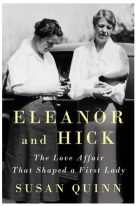 Quinn, Susan. Eleanor and Hick: The Love Affair That Shaped a First Lady. Penguin, 2016. HC. $30. ISBN 978-1594205408.
Quinn, Susan. Eleanor and Hick: The Love Affair That Shaped a First Lady. Penguin, 2016. HC. $30. ISBN 978-1594205408.
As a long-time Eleanor Roosevelt aficionada, I eagerly awaited this book, though my enthusiasm for all things “ER”-related has always been tempered with skepticism concerning her relationship with journalist Lorena Hickok. Where, I’m always asking rhetorically, is the smoking gun that proves they had more than just a loving friendship? In this excellent book, veteran biographer Quinn offers readers no such firearm, but puts the women’s undeniable union into a new context, one with which I, and perhaps others, can live comfortably.
Lorena Hickok was an accomplished Associated Press reporter when she began covering ER during FDR’s 1932 presidential campaign. The women’s personal bond quickly deepened, as reflected in the copious letters they exchanged, even though, according to Quinn, the intensity of their relationship would be on the downhill slide by 1934. However, they continued corresponding for decades to come.
Since she could no longer maintain “critical distance” regarding ER’s activities, Hickok left her position with the AP and moved into the White House, finding other non-journalistic work along the way. But even that drastic step did not guarantee more access to the woman she called “Lady”. The two of them spent as much time alone together as feasible, but as ER’s duties as First Lady and personal commitments to her various “causes” exploded in quantity, private getaways became less and less workable.
Perhaps inevitably, ER’s seeming 24/7 “busy-ness” (including her syndicated newspaper column “My Day”) eventually led to the diminution of their daily relationship. In time, each of them found other companionship: Hick had several female romantic partners, while ER formed possessively emotional attachments to younger men in her circle, such as Joseph Lash and David Gurewitsch.
Eleanor and Hick’s emotional bond was undeniable, but was it also intimate? Quinn cannot answer this definitively, but surmises that, due to ER’s “visceral dislike of physical contact,” their sexual activity could well have been limited. Other scholars may believe the women’s letters indicate otherwise, but I find Quinn’s theory credible. This scenario makes more sense to me than does the image of a no-holds-barred coupling, especially given the demanding and very public circumstances in which these women lived and functioned.
After FDR’s death in 1945, ER and Hick drifted even further apart, as Eleanor finally felt “free” enough to pursue political interests, becoming “First Lady of the World” to one and all. Hick faced declining health and the need for paid employment, eventually finding late-life success writing books for young people. Prior to Eleanor’s death in 1962, ER’s and Hick’s moments together were fleeting, but still meaningful. Lorena Hickok died in 1968 from complications of diabetes.
Eleanor and Hick is a wonderfully written, insightful portrait of two exceptional women, caught up in a powerful relationship that clearly altered both their lives. It is highly recommended for all history and biography collections.
Cathy Ritchie
Acquisitions/Selection Services
Dallas (TX) Public Library
